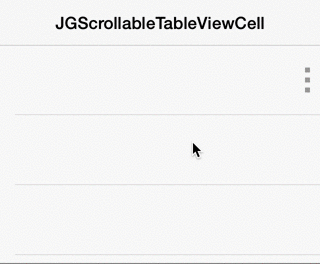JGScrollableTableViewCell 1.1
| TestsTested | ✗ |
| LangLanguage | Obj-CObjective C |
| License | MIT |
| ReleasedLast Release | Dec 2014 |
Maintained by Jonas Gessner.
- By
- Jonas Gessner
- JonasGessner
© 2013-2014 Jonas Gessner
JGScrollableTableViewCell is a simple and easy to use UITableViewCell subclass with a scrollable content view that exposes an accessory view when scrolled. The behavior is inspired by the iOS 7 mail app.
Current Version: 1.1
Requirements
• iOS 5 or higher
• Built with ARC (If your Xcode project doesn't use ARC then set the -fobjc-arc compiler flag)
• Foundation, UIKit and CoreGraphics frameworks
Getting started
JGScrollableTableViewCell works just like any other UITableViewCell: Highlighting, selection, and UITableViewDelegate calls all work like normal. The only difference is that the cell's contentView is covered by a UIScrollView that basically becomes the new content view – which is scrollable.
An "option view" can be assigned to the cell, which is placed behind the scroll view, making it possible to scroll on the cell to reveal the option view behind it.
Note: You should always use custom subclasses of JGScrollableTableViewCell that add your custom content to the cell (ex labels & image views).
Installation
CocoaPods:
Add this to your Podfile:
pod 'JGScrollableTableViewCell', '1.1'
Add source files:
Drag the JGScrollableTableViewCell folder into your project.
After you have included JGScrollableTableViewCell in your project, simply #import "JGScrollableTableViewCell.h" and you are ready to go!
Documentation
By default JGScrollableTableViewCell has an empty scroll area, and no option view. Here's a guide through the entire JGScrollableTableViewCell class:
The scroll view
- (UIScrollView *)scrollView;Returns the scroll view used in the cell. Do not add any subviews to the scrollview or modify its frame, bounds, contentOffset or contentInset.
- (void)setScrollViewInsets:(UIEdgeInsets)scrollViewInsets;Insets the scroll view. Useful for displaying a border around the scroll area (when also setting contentView.backgroundColor)
- (void)setScrollViewBackgroundColor:(UIColor *)scrollViewBackgroundColor;Sets the background color of the scroll view. Equivalent to contentView.backgroundColor on a regular UITableViewCell.
- (BOOL)isScrolling;Returns YES if the user is currently dragging the scroll view or if the scroll view is decelerating.
- (void)setGrabberView:(UIView *)grabberView;Sets a view to use as a grabber for the scroll view. This view is static, so it won't be resized at all by the cell. If this view is \c nil then the entire area of the scroll view is scrollable, if this view is set then scrolling can only be performed on this view.
The option view
- (void)setOptionView:(UIView *)view ;Sets a new option view & removes the old option view. The option view will be dynamically resized to fit the cell's size and the scroll view's insets. The only parameter of the option view's frame that is not changed is the width. The width should be set before passing the view to this method and should not be changed afterwards.
- (UIView *)optionView;Returns the current option view.
- (void)setOptionViewVisible:(BOOL)optionViewVisible animated:(BOOL)animated;Opens or closes the option view with an optional 0.3 second animation.
Scrollable content
- (void)addContentView:(UIView *)view;You should at no point add a view to the cell's directly or to its contentView. Instead, pass views that should be displayed on the cell to this method. Views passed to this method will appear in the scrollable area of the cell.
Delegate
JGScrollableTableViewCell has a delegate that conforms to the JGScrollableTableViewCellDelegate protocol. It is used for handling scroll events.
@property (nonatomic, weak) id <JGScrollableTableViewCellDelegate> scrollDelegate;
The JGScrollableTableViewCellDelegate protocol declares three optional (self explaining) methods:
- (void)cellDidBeginScrolling:(JGScrollableTableViewCell *)cell;
- (void)cellDidScroll:(JGScrollableTableViewCell *)cell;
- (void)cellDidEndScrolling:(JGScrollableTableViewCell *)cell;Ideally, your UITableViewDelegate should also be your JGScrollableTableViewCellDelegate.
Custom Touch handling
In some special cases custom touch handling may be needed (see Advanced example project). There are two blocks that can be used for customizing the scrolling behavior.
@property (nonatomic, copy) void (^scrollViewDidScrollBlock)(JGScrollableTableViewCell *cell, UIScrollView *scrollView);This block is invoked when the scroll view scrolls. Can be used to add custom behavior to the scroll view.
Advanced usage
Management of opened option views
JGScrollableTableViewCellManager
+ (void)closeAllCellsWithExceptionOf:(JGScrollableTableViewCell *)cell stopAfterFirst:(BOOL)stop;This closes all option views in the table view that contains cell. stop is a flag that can increase performance by stopping the enumeration of cells after the first cell with an opened option view has been found and closed. Set this flag to YES when you have set up a JGScrollableTableViewCellDelegate to only allow one opened option view at a time (like in the following example).
Using this method call we can set up our table view to only allow one option view to be opened at at time:
- (void)cellDidBeginScrolling:(JGScrollableTableViewCell *)cell {
[JGScrollableTableViewCellManager closeAllCellsWithExceptionOf:cell stopAfterFirst:YES];
}
- (void)cellDidScroll:(JGScrollableTableViewCell *)cell {
[JGScrollableTableViewCellManager closeAllCellsWithExceptionOf:cell stopAfterFirst:YES];
}
- (void)cellDidEndScrolling:(JGScrollableTableViewCell *)cell {
[JGScrollableTableViewCellManager closeAllCellsWithExceptionOf:cell stopAfterFirst:YES];
}Surviving UITableView's cell reuse
Because UITableView reuses cells it is important to set the opened state of each cell when the UITableViewDataSource loads its data. To remember which cell was opened you can modify the cellDidEndScrolling: method to take note of the cell with the currently opened option view:
- (void)cellDidEndScrolling:(JGScrollableTableViewCell *)cell {
if (cell.optionViewVisible) {
_openedIndexPath = [self.tableView indexPathForCell:cell];
}
else {
_openedIndexPath = nil;
}
[JGScrollableTableViewCellManager closeAllCellsWithExceptionOf:cell stopAfterFirst:YES];
}(_openedIndexPath is an instance variable)
The tableView:cellForRowAtIndexPath: method should contain this code to update each cell's optionViewVisible state:
- (UITableViewCell *)tableView:(UITableView *)tableView cellForRowAtIndexPath:(NSIndexPath *)indexPath {
static NSString *const CellIdentifier = @"ScrollCell";
JGScrollableTableViewCell *cell = [tableView dequeueReusableCellWithIdentifier:CellIdentifier forIndexPath:indexPath];
[cell setOptionViewVisible:[_openedIndexPath isEqual:indexPath]]; //this correctly sets the opened state of the cell's option view.
return cell;
}
Examples
There are two example projects located in the Examples folder.
Credits
Created by Jonas Gessner. ©2013-2014
Contribution
You are welcome to contribute to the project by forking the repo, modifying the code and opening issues or pull requests.
License
Licensed under the MIT license.
